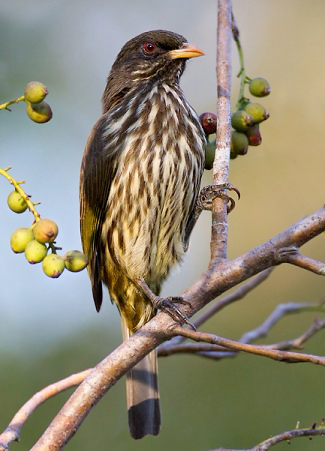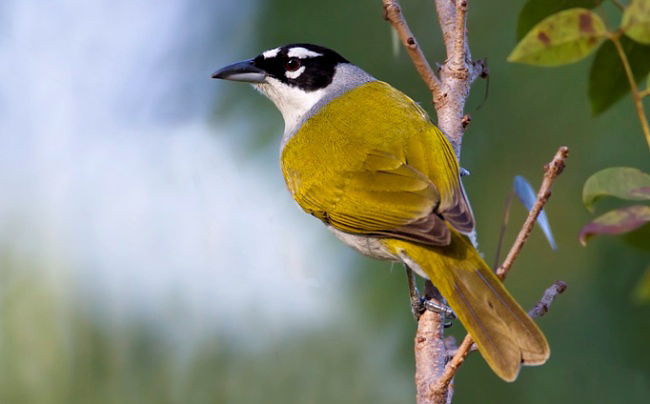

The endemic Palmchat in Santo Domingo Botanical Gardens by Dubi Shapiro.
- Three bird families endemic to Hispaniola which the Dominican Republic shares with Haiti; the monotypic Palmchat, the two Chat Tanagers and three of the four Hispaniolan Tanagers; Black-crowned Palm-tanager, and Green-tailed and White-winged Warblers
- 33 of the 34 Hispaniolan endemics, including Hispaniolan Amazon, Hispaniolan Lizard-cuckoo, Bay-breasted Cuckoo, Hispaniolan Trogon, Broad-billed and Narrow-billed Todies, and La Selle Thrush
- And some of the Caribbean's and the world's most spectacular other birds, such as White-tailed Tropicbird, Magnificent
Frigatebird and Vervain Hummingbird,
the second smallest bird in the world - While at sea lies the Silver Bank where one
of the world’s largest concentrations of
Humpback Whales gathers - And it is possible to swim with them!
- Swimming with the whales usually involves living a week or so aboard a suitable vessel, donning wetsuit, mask and snorkel, being able to swim a minimum of 50 metres in the open sea and staying in the water, with a buoyancy aid if required, for up to three hours at a time. No scuba-diving or free-diving is allowed, there are strict guidelines about how to behave in the water while waiting for the whales to pass by, and tourist numbers are limited to less than 600 per season, all of which help to maximise the chances of enjoying one of the ultimate wildlife experiences, possibly completed with whale song.
- The forests on the slopes of the Sierra de Bahoruco, where virtually all the endemics occur, are being swept down by a tide of refugees from the already cleared hillsides of adjacent Haiti, clearing land mostly it seems as cheap labour for local landowners making money from charcoal and then crops. The birds live on, in increasingly fragmented forest, but for how long?
- Some birding tour companies combine the Dominican Republic with Puerto Rico where there are 16 endemic bird species including Puerto Rican Tody and Elfin Woods Warbler.
Best Birds and other wildlife in the Dominican Republic
Birds
The species lists below are for the northern winter.
Endemics (Haiti and Dominican Republic) 31 (+ 3 single-country endemics = 34) Least Poorwill (Pauraque), Hispaniolan (Greater Antillean) Nightjar, Hispaniolan (Antillean) Mango, Hispaniolan Emerald, Bay-breasted Cuckoo, Hispaniolan Lizard-cuckoo, Ashy-faced Owl, Hispaniolan Trogon, Narrow-billed Tody, Broad-billed Tody, Antillean Piculet, Hispaniolan Woodpecker, Hispaniolan Amazon, Hispaniolan Parakeet, Hispaniolan (Greater Antillean) Elaenia, Hispaniolan Pewee, Flat-billed Vireo, White-necked Crow, Hispaniolan Palm Crow, La Selle Thrush, Palmchat, Hispaniolan (Antillean) Euphonia, Hispaniolan Crossbill, Antillean Siskin, Hispaniolan Oriole, Black-crowned Palm-tanager, White-winged Warbler, Green-tailed Warbler, Hispaniolan Spindalis, Western Chat-tanager and Eastern Chat-tanager.
Haiti 1 Grey-crowned Palm-tanager.
Dominican Republic 2 White-fronted (Grey-headed) Quail-dove and Ridgway’s Hawk (small range).
Near-endemics
Hispaniola and Jamaica 3 Vervain Hummingbird, Stolid Flycatcher and Golden Swallow.
Other Caribbean Endemics
West Indian Whistling Duck, Plain Pigeon, Key West Quail Dove, Antillean Palm Swift, Vervain Hummingbird, Loggerhead Kingbird, Rufous-throated Solitaire,
Eastern Red-legged Thrush, Greater Antillean Bullfinch and Greater Antillean Grackle.
Others
White-tailed Tropicbird, Magnificent Frigatebird, White-cheeked Pintail, Brown Pelican, Little Blue and Tricoloured Herons, Turkey Vulture, Purple
Gallinule, wintering and passage migrant shorebirds, Laughing Gull, Royal Tern, Scaly-naped and White-crowned Pigeons, Zenaida Dove, Mangrove Cuckoo,
Smooth-billed Ani, Burrowing Owl, Antillean Nighthawk, Northern Mockingbird, Pine and Yellow (Golden) Warblers, and Bananaquit. Also a chance of
American (Caribbean) Flamingo, Reddish Egret (white morph), Roseate Spoonbill, Limpkin, Northern Potoo, and wintering/passage migrant passerines such
as Bicknell’s Thrush, Northern Parula, Black-and-white, Black-throated Blue, Black-throated Green, Cape May and Prairie Warblers, American Redstart,
Ovenbird and Common Yellowthroat.
Mammals
Humpback Whale (Dec-Apr, mostly Jan-Mar). Also a chance of Sperm, Pygmy Sperm and False Killer Whales,
and (Atlantic) Bottlenose, Fraser’s, Risso’s, Spinner and (Atlantic) Spotted Dolphins, and an outside chance of Hispaniolan Solenodon and Hutia
(both most likely in the dry season, especially late January, near Pedernales, when they can be heard rustling the dead leaves).
Reptiles, Amphibians and Fish
Dwarf Gecko, the world's smallest lizard, occurs in Jaragua National Park.
Best Sites for Birds and other wildlife in the Dominican Republic

A Black-crowned Palm-tanager in Santo Domingo Botanical Gardens by Dubi Shapiro.
- Santo Domingo Botanical Gardens Palmchat, West Indian Whistling Duck, Hispaniolan Lizard-cuckoo, Antillean Nighthawk, Vervain Hummingbird, Hispaniolan Mango, Hispaniolan Woodpecker and Black-crowned Palm-tanager.
- Silver Bank Humpback Whale. Also a chance of Sperm, Pygmy Sperm and False Killer Whales, and dolphins.
- Sierra de Bahoruco Most of the endemics listed above, Caribbean endemics such as Key West Quail Dove, Rufous-throated Solitaire and Greater Antillean Bullfinch, and Scaly-naped Pigeon, Ruddy Quail Dove and Pine Warbler. Also a chance of Bicknell’s Thrush and an outside chance of Hispaniolan Solenodon.
- Oviedo Lagoon Ducks and shorebirds. Also a chance of American Flamingo.
- Lago Enriquillo Hispaniolan Palm and White-necked Crows, White-cheeked Pintail and other waterbirds including a chance of American Flamingo.
- Cabo Rojo A chance of (usually distant) White-tailed Tropicbird.
- Los Haitises NP Ridgway's Hawk, Palmchat, Plain Pigeon, Mangrove Cuckoo, Vervain Hummingbird, Cave Swallow, Caribbean Martin, White-necked Crow and warblers such as Cape May.
Best Times for Birds and other wildlife in the Dominican Republic
Humpback Whales are usually present from December to mid-April with the peak time to swim with them being January to March. Female whales usually give birth in February so March is a good time to see mothers with calves. The best time for birds is usually mid-February to mid-April at the beginning of the breeding season.
Recommended Bird Books etc. for the Dominican Republic
Ruta Barrancoli: A Bird-Finding Guide to the Dominican Republic by S C Latta and K J Wallace. 2012. Available from steven.latta@aviary.org or National Aviary, Allegheny Commons West, Pittsburgh, PA 15212-5248, USA.
Birds of the Dominican Republic and Haiti by S C Latta et al. Helm/Princeton University Press, 2006.
Collins Field Guide: Birds of the West Indies by N Arlott. Harper Collins, 2010.
Birds of the West Indies by H Raffaele et al. Helm, 1998.
A Field Guide to the Birds of the West Indies by James Bond. Originally published in 1936 by the Academy of Natural Sciences and reprinted many times since by several publishers including Collins and Houghton Mifflin.
National Audubon Society Field Guide to Tropical Marine Fishes by C L Smith. Alfred A Knopf, 1997.
Butterflies of the Caribbean and Florida by P Stiling. Macmillan Caribbean, 1999.
Apps etc.
The Birds of Haiti and the Dominican Republic.
Where to watch birds in Central America & the Caribbean by N Wheatley and D Brewer. Helm, 2001.
Don’t know which country/countries/regions to visit in the Caribbean? Then it may be worth considering taking a look at this book, written by this website’s author and David Brewer. It is many years old of course but it still provides a starting point, an overview and a guiding light to the best birds and the best places to look for them in the region, and could save hours of searching for similar information on the internet. However, it is important to check more up-to-date sources for sites which have been opened up, sites and species which have been discovered, lodges that have been built etc. since the book was published.
Birding and Wildlife Trip Reports for the Dominican Republic
Many trip reports, some for the Dominican Republic, are posted on the websites listed here. On some of these websites some reports are independent and some are posted by tour companies who organize tours to the Dominican Republic. These tour companies and others also post their own reports on their websites, which are listed under 'Some Organized Tours to the Dominican Republic' below.
- The best website for trip reports is CloudBirders
- but these are also worth a look
- Birdtours
- Fatbirder
- Jon Hornbuckle
- Mammal Watching
Local bird and wildlife guides in the Dominican Republic
The costs of organized tours partly reflect the quality of the tour leaders. Some leaders are certainly better than others and many companies claim their leaders are the best but even the best rely at least to some extent on the exceptional skills of the local guides they employ. If you are travelling independently, employing such local guides will greatly increase your chances of seeing the wildlife you wish to see.
Accommodation for birders in the Dominican Republic
Some Organized Tours for birds and other wildlife to the Dominican Republic
There are many tour companies who organize tours to see mammals, birds, other wildlife and other natural wonders. The cost of these tours vary considerably according to such variables as the airlines used, the number of days the tours last, the number of sites visited, the number of people in the group (an important consideration if you wish to see such wildlife as rainforest mammals and birds), the number of tour leaders, the standard of accommodation and transport, and the percentage profit the company hopes to make. Generally, where the number of days tours last and the number of sites visited are similar, the cheapest tours are those that use the cheapest airlines, accommodation and local transport, that have the largest groups with the least number of leaders, and that make the least amount of profit. The most expensive tours tend to be those which are exceptionally long, use the most expensive accommodation (ridiculously lavish in some cases, even for single nights) and which make the most profit. Some tour costs partly reflect the quality of the tour leaders. Some leaders are certainly better than others and many companies claim their leaders are the best but even the best rely at least to some extent on the exceptional skills of the local guides they employ.
While tour companies organize tours with set itineraries many also organize custom tours for individuals and private groups who instead of taking a tour with a set itinerary want to follow their own itinerary to suit their own personal tastes, whether it be mammals, birds, other wildlife, other natural wonders or even man-made attractions, or a mixture of them all. Many organized tours with set itineraries are also fast-paced and target as many species as possible, whether they are mammals, birds or other wildlife or everything, which usually leaves little time to enjoy the best sites and individual species, but on a custom tour those taking part can specify the pace and the sites and species they wish to concentrate on. Custom tours also suit people who like to travel with people they already know, rather than with a group of strangers, and people with partners with different interests. Individuals and small groups will almost certainly have to pay more than the price of an organized tour with a set itinerary but a large group of friends may be able to travel for less than the price quoted for a set tour.
Tour companies who are running organized tours to the Dominican Republic in the next couple of years include the following. Many of these also offer custom tours.
